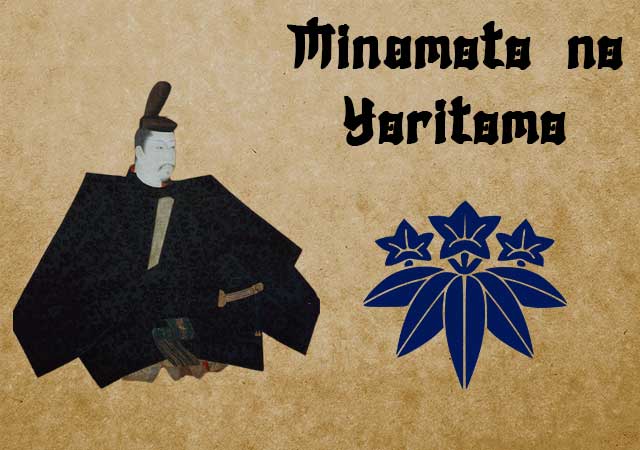
Minamoto no Yoritomo's paternal grandfather, Minamoto no Tameyoshi, led the esteemed Minamoto clan, while his maternal grandfather, a member of the renowned Fujiwara clan, served as the chief priest at Atsuta Shrine, the second most revered Shinto Shrine in Japan after the Great Shrine of Ise. Yoritomo's mother had returned to her hometown, now Nagoya, and Yoritomo was born in Atsuta (Nagoya) on May 9, 1147, at the location where the Seigan-ji Temple stands today.
In 1156, the Hogen Disturbance, a brief civil war, erupted over a dispute within the Imperial Court, divided between two branches led by the former Emperor Toba, supported by influential Fujiwara clan members and Taira no Kiyomori, and Toba's eldest son, the former Emperor Sutoku, backed by other Fujiwara clan members and hereditary Imperial regents.
After the conflict, Yoritomo's father assumed leadership of the Minamoto clan, and due to Yoritomo's mixed Minamoto and Fujiwara lineage, he became the heir, receiving his initial court title. The two rival families clashed again in the Heiji Disturbance, resulting in the Minamoto's defeat. With the Taira now dominant in Japan, the Minamoto faced execution or exile. Yoritomo, however, was spared. In 1179, he married into the Hojo clan, which supported his petition to reclaim leadership of the Minamoto clan, challenging the Taira's authority. Over the subsequent years, he gradually built a power base and witnessed the Taira's decisive defeat at the naval Battle of Dan-no-Ura in 1185. This victory granted him the freedom to establish a government in Kamakura in 1192, where he ruled until his accidental death at the age of 51 on February 9, 1199, following a fall from his horse the previous day.
See also
-
Yamagata Masakage

Masakage was one of Takeda Shingen’s most loyal and capable commanders. He was included in the famous list of the “Twenty-Four Generals of Takeda Shingen” and also belonged to the inner circle of four especially trusted warlords known as the Shitennō.
-
Yagyu Munenori

Yagyū Munenori began his service under Tokugawa Ieyasu while his father, Yagyū Muneyoshi, was still at his side. In 1600, Munenori took part in the decisive Battle of Sekigahara. As early as 1601, he was appointed a kenjutsu instructor to Tokugawa Hidetada, Ieyasu’s son, who later became the second shogun of the Tokugawa clan.
-
Yagyu Muneyoshi

A samurai from Yamato Province, he was born into a family that had been defeated in its struggle against the Tsutsui clan. Muneyoshi first took part in battle at the age of sixteen. Due to circumstances beyond his control, he was forced to enter the service of the Tsutsui house and later served Miyoshi Tōkei. He subsequently came under the command of Matsunaga Hisahide and in time became a vassal first of Oda and later of Toyotomi.
-
Endo Naozune

Naozune served under Azai Nagamasa and was one of the clan’s leading vassals, renowned for his bravery and determination. He accompanied Nagamasa during his first meeting with Oda Nobunaga and at that time asked for permission to kill Nobunaga, fearing him as an extremely dangerous man; however, Nagamasa did not grant this request.
-
Hosokawa Sumimoto

Sumimoto came from the Hosokawa clan: he was the biological son of Hosokawa Yoshiharu and at the same time the adopted son of Hosokawa Masamoto, the heir of Hosokawa Katsumoto, one of the principal instigators of the Ōnin War. Masamoto was homosexual, never married, and had no children of his own. At first he adopted Sumiyuki, a scion of the aristocratic Kujō family, but this choice provoked dissatisfaction and sharp criticism from the senior vassals of the Hosokawa house. As a result, Masamoto changed his decision and proclaimed Sumimoto as his heir, a representative of a collateral branch of the Hosokawa clan that had long been based in Awa Province on the island of Shikoku. Almost immediately after this, the boy became entangled in a complex and bitter web of political intrigue.
-
Honda Masanobu

Masanobu initially belonged to the retinue of Tokugawa Ieyasu, but later entered the service of Sakai Shōgen, a daimyo and priest from Ueno. This shift automatically made him an enemy of Ieyasu, who was engaged in conflict with the Ikkō-ikki movement in Mikawa Province. After the Ikkō-ikki were defeated in 1564, Masanobu was forced to flee, but in time he returned and once again entered Ieyasu’s service. He did not gain fame as a military commander due to a wound sustained in his youth; nevertheless, over the following fifty years he consistently remained loyal to Ieyasu.
-
Honda Masazumi

Masazumi was the eldest son of Honda Masanobu. From a young age, he served Tokugawa Ieyasu alongside his father, taking part in the affairs of the Tokugawa house and gradually gaining experience in both military and administrative matters. At the decisive Battle of Sekigahara in 1600, Masazumi was part of the core Tokugawa forces, a clear sign of the high level of trust Ieyasu placed in him. After the campaign ended, he was given a highly sensitive assignment—serving in the guard of the defeated Ishida Mitsunari, one of Tokugawa’s principal enemies—an obligation that required exceptional reliability and caution.
-
Hojo Shigetoki

Hōjō Shigetoki, the third son of Hōjō Yoshitoki, was still very young—only five years old—when his grandfather Tokimasa became the first member of the Hōjō clan to assume the position of shogunal regent.

